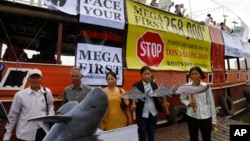A two-day meeting in Laos regarding the construction of a 260-megawatt dam on the Lower Mekong River has left officials and the environmental communities deeply polarized. The Lao government remains determined to press ahead with the project, dismissing concerns over the dam’s impact on the Mekong Delta region.
The planned Don Sahong hydropower dam, in southern Champassak province, is one of nine on the Mekong river's mainstream in Laos or near the Lao-Thai border.
Laos is heavily dependent on income from some 10 hydropower plants, largely built since the 1990s on tributaries and rivers within Laos. They generate some 2,000 megawatts of power for domestic use and for export to Thailand.
But two new massive dams have stoked controversy. One, the $3.8 billion Xayaburi dam in northern Laos, and the $600 million Don Sahong planned, for the Khone Falls in Chamapssak province, have drawn scrutiny from environmentalists who worry about their impact on migratory fish and water flow.
Laos' vice minister of Energy and Mines, Viraphonh Virapong, said the government is committed to what he terms developing clean, renewable hydropower, despite criticisms.
To evaluate the impact of the dams, the intergovernmental Mekong River Commission (MRC), last week oversaw consultations to evaluate the impact of the projects.
Robert Mather, South East Asia head for the International Union for the Conservation of Nature (IUCN), said there are serious questions about whether this evaluation process is worthwhile.
"Three main issues - the timing of the process, the lack of clarity about really the limits of what the process is actually about and the lack of any real trans-boundary EIA (Environmental Impact Assessment) discussions around, then I really don't think you can expect the process to really yield anything meaningful," said Maher.
The consultation process for the Don Sahong project will last only six months. The Laos government sees the meetings as a way to clarify problem areas in construction of the dams, but critics say the talks should raise issues leading to the project being halted.
Environmental groups, including the World Wide Fund for Nature (WWF) and the U.S.-based International Rivers and Thailand's Towards Ecological Recovery and Regional Alliance (TERRA), say the Don Sahong will disrupt the movement of migratory fish and impact local communities.
TERRA spokesperson Premrudee Daorung said consultations are failing to address these issues, especially because few communities dependent on the waters for their livelihoods are involved in the process.
"What we keep requesting is that the MRC itself, with its agenda, it has to include the local people; you cannot keep going along with the project or the platform that only allows so-called dam builders to attend," said Daorung.
Throughout the Greater Mekong Subregion up to 60 million people are dependent on fish and free flowing waters, as vital flood water runoff is needed to enrich soil for agriculture, especially rice.
Downstream, Vietnam has raised alarms over the impact the Don Sahong project would have on the Mekong Delta, the country's “rice bowl” and home to 20 million people. Vietnam says the dam will result in increasing water salinity and soil erosion.
An MRC spokesman told VOA national consultations are set to be held in Vietnam, Thailand and Cambodia, before final decisions are made on the project.







